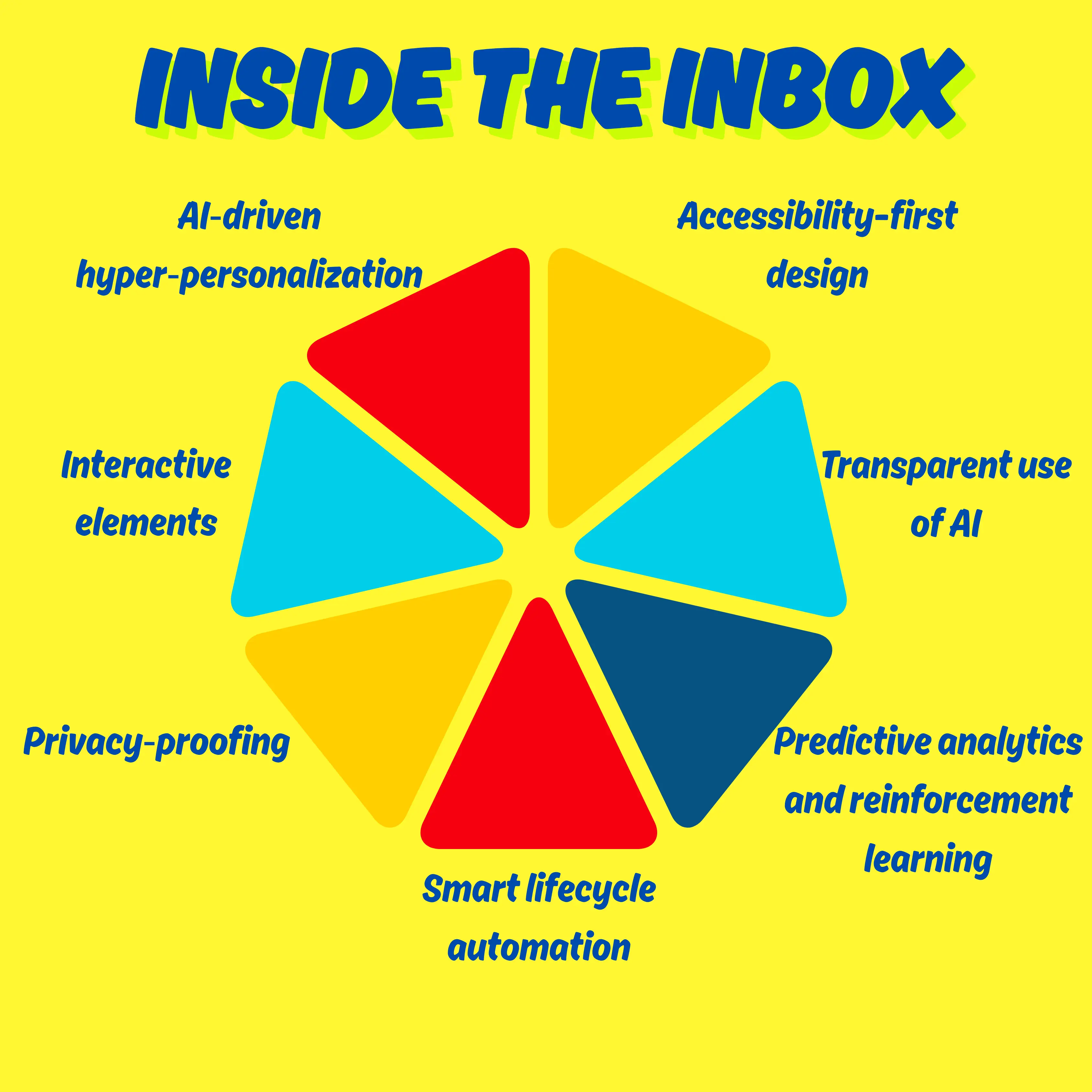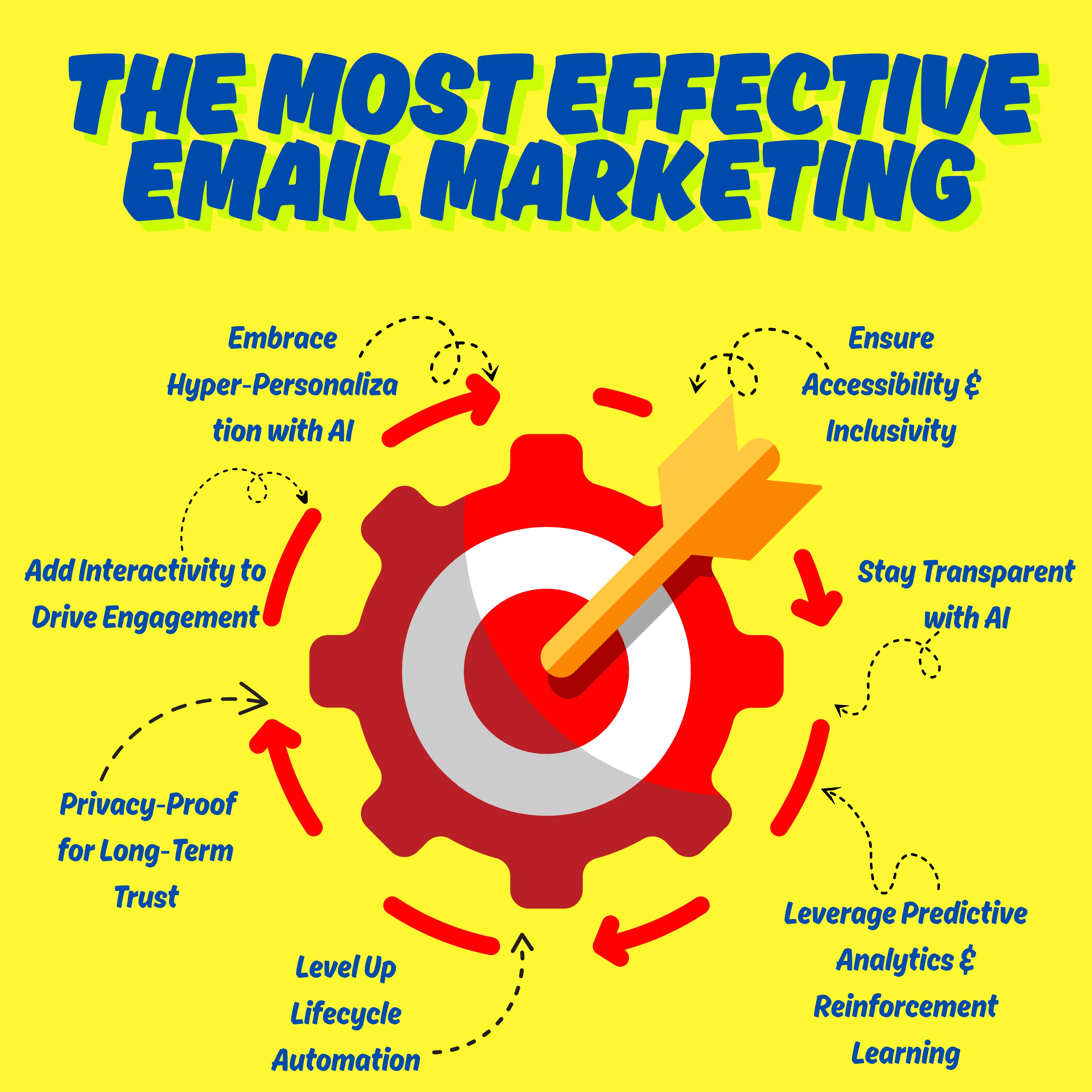The Most Effective Email Marketing Strategy
Inside the Inbox
Let’s recap the key elements we’ve woven together:
| 1 | AI‑driven hyper‑personalization for subject lines, content, and sends |
| 2 | Interactive elements—videos, surveys, quizzes—right inside the email |
| 3 | Privacy‑proofing to ensure compliance and trust |
| 4 | Smart lifecycle automation optimized with real-time data |
| 5 | Predictive analytics and reinforcement learning powering continuous improvement |
| 6 | Transparent use of AI, building trust with your audience |
| 7 | Accessibility-first design, ensuring inclusive reach |

How to Craft the Most Effective Email Marketing Strategy

In today’s fast-paced digital world, effective email marketing goes far beyond sending monthly newsletters. As we’ve discussed, the best strategies now combine personalization, interactivity, and strategic automation. Here’s a comprehensive guide on building an email marketing strategy that delivers real results, and stays ahead in 2025 and beyond.
1. Embrace Hyper‑Personalization with AI
We’ve learned that generic "Hi [Name]" emails no longer cut it. Today, AI-driven hyper-personalization is a game-changer, crafting subject lines, email bodies, and product recommendations tailored to individual behavior. Tools from Shopify to Oracle now allow dynamic content blocks that adapt in real-time based on each recipient’s actions and preferences . When we use AI to segment audiences and predict send times, our open rates and clicks climb higher than ever.
2. Add Interactivity to Drive Engagement
As we just discussed above, static emails feel outdated. Interactive emails, complete with surveys, quizzes, carousels, or embedded videos, turn your messages into immersive experiences. Engagement skyrockets when readers can click without leaving their inbox. For example, video emails from providers like EyeMail can boost click‑through rates by up to 300%. When audiences interact, you collect valuable data to inform future campaigns.
3. Privacy‑Proof for Long‑Term Trust
As we’ve discussed, privacy isn’t just about compliance, it’s central to customer trust. With growing regulations like GDPR and CCPA, email programs must be privacy‑proofed for resilience. Use transparent consent flows, minimize data collection, and offer easy unsubscribe options. When you show respect for subscribers’ data, you build long-term loyalty and better deliverability.
4. Level Up Lifecycle Automation
Earlier, we mentioned how intelligent lifecycle flows are key. Automated journeys; from welcome sequences to cart abandonment and re‑engagement, ensure timely, relevant touchpoints . Today, AI can layer machine learning on top of these workflows; refining content, delivery time, and offers using real-time behavior. The result? Smart automation that interacts efficiently without overpowering the user experience.
5. Leverage Predictive Analytics & Reinforcement Learning
Building on our foundation, consider using predictive algorithms and reinforcement‑learning A/B testing. A new framework (RL‑LLM‑ABTest) automates dynamic content testing, tracking which variations perform best and optimizing over time. These tools enable your emails to consistently evolve and get smarter over time. It's like having a data scientist embedded in your email tool!
6. Stay Transparent with AI
We’ve covered AI everywhere, but transparency matters. As marketers embrace generative AI for copy, image generation, and scheduling, being upfront builds trust. Let subscribers know when content is AI‑assisted. It reinforces authenticity and positions your brand as both modern and mindful.
7. Ensure Accessibility & Inclusivity
Continuing with our thoughtful approach, better email marketing means making emails accessible to all. Design with screen reader support, descriptive ALT text, strong contrast visuals, and clear, minimal layouts. When your emails speak to everyone, they don’t just travel further, they build lasting trust and show your brand stands for something bigger.
If you found this guide helpful, keep exploring our blog for more actionable tips, expert strategies, and AI-driven insights to supercharge your email marketing.
Read More Insights on Email Marketing. Stay ahead, stay connected, and stay in their inbox, the smart way.
Conclusion
As we've discussed, the most effective email marketing strategy in 2025 is one that blends intelligent personalization, immersive experiences, automated journeys, and ethical data practices, all underpinned by cutting-edge AI. Whether you’re sending a quiz, an AI‑tailored offer, or a video greeting, aim to create relevant moments that resonate deeply.
By adopting this multifaceted approach, not just tactics, you’ll cultivate lasting engagement, stronger loyalty, and higher ROI. And remember: in email marketing, as in any relationship, authenticity, respect, and attention make all the difference.
FAQs
Q1. What is the most effective email marketing strategy in 2025?
The most effective strategy blends AI-driven personalization, interactive content, automation, privacy compliance, predictive analytics, and accessibility-first design. These elements together increase engagement, improve ROI, and build lasting subscriber trust.
Q2. How does AI improve email marketing performance?
AI enhances subject lines, message content, and delivery timing by leveraging live data and audience behavior patterns. It enables hyper-personalized experiences and lifecycle automation that increase open and click-through rates while reducing manual effort.
Q3. What are interactive emails, and why are they important?
Engaging emails feature built-in videos, polls, image sliders, or interactive quizzes. They improve engagement by allowing recipients to interact without leaving their inbox, which boosts click-through rates and gathers valuable behavioral insights.
Q4. How can I ensure my email campaigns are privacy-compliant?
Use clear opt-in forms, provide unsubscribe links, collect minimal data, and comply with regulations like GDPR and CCPA. Transparent data practices help build trust and improve deliverability.
Q5. What is lifecycle email automation, and how does it work?
Lifecycle automation delivers timely, behavior-based emails throughout the customer journey—like welcome sequences, abandoned cart reminders, and win-back campaigns. Modern platforms use AI to optimize these journeys in real time.

